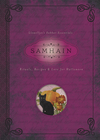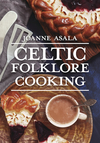Halloween: A Time For Divination and Communication

As the long, warm summer draws to a close, the dark dawn of November provides a special, quiet time for reflection and transition. The transition from October to November can be stark; from crisp, comfortable days to the onset of white skies and barren trees. Our bodies react to the chill in the air and the desolation of the landscape by mentally saying farewell to all the lush opulence summer provided; the boundless energy; the early rising of the sun. For centuries our ancestors have done just that, and prepared for the long winter ahead.
"Samhain is derived from the Old Irish sam (summer) and fuin (end), which renders the meaning of Samhain as the end of summer." Raven Grimassi tells us in Witchcraft: A Mystery Tradition. "Among the ancient Gauls this season began the new year, for it was an ancient belief that darkness precedes light. Therefore, the new year itself was born from darkness, as are all things that emerge from a womb."
A major aspect of Samhain is the brief connection it opens to the Otherworld. This has always made it a time to communicate with the deceased. Grimassi writes, "An ancient European belief held that the borders between the natural and so-called supernatural worlds became passable. It was thought that the spirits and souls of the departed could come and go as they pleased during this period of time." Hence we have the tradition of "dumb suppers," or eating an entire meal in silence with plates of food set out for passed on family members. Favorite foods are cooked especially for departed souls to invite them to the table, and in some countries this is the time to visit cemeteries, leaving candles burning and tokens of affection on their graves. You can also use this time to quietly commune with the dead and listen for their answers, as detailed in "A Simple Ritual to Receive Answers from the Dead"presented below.
Because of the ethereal, transitory quality of this period, it was also considered an excellent time for divination. In Halloween, Silver RavenWolf gives numerous examples of fortune-telling methods using traditional Samhain symbols such as apples, nuts, and pumpkin seeds. For example, she writes:
"If a girl peels an apple in one long piece at midnight on Halloween, and then tosses the peel over her left shoulder or into a bowl of water, she will be able to read the first initial of her future partner's name in the shape assumed by the discarded peel."
Many divination methods became party games in the early twentieth century, such as bobbing for apples, where again the emphasis was on who would marry whom, or be the first to marry. In Celtic Folklore Cooking, Joanne Asala tells us that charms were baked into bread on Samhain for divination. We have included a recipe here so that you can try it out yourself. You may want to modernize this tradition with symbols of your own, as "spinsterhood" is not quite as relevant to our society as it once was.
Of course, there are countless other methods of divination, including tarot cards, palmistry, runes, and more. For more excellent divination ideas for Samhain, read Lisa Finander's article "Samhain: A Powerful Time for Divination." Have a safe and enchanted Halloween!
Hallowe'en Barm Brack
Hallowe'en comes from the Celtic celebration of Samhain, known as the "split between the worlds," where time ceases to exist and mortals may get a glimpse of the Otherworld. As Samhain is a time of fortunetelling and divination, various objects may be wrapped up in waxed paper and baked into the barm brack. Traditionally these items include a thimble, representing spinsterhood; a pea, for poverty; a wedding ring, for marriage; a coin, for wealth; and a stick, representing a walking stick for one who is to travel far. "Barm" comes from the Anglo-Saxon word beorma, which was a fermented liquor that was used to raise a cake. "Brack" comes from the Irish word brac, meaning "speckled." I once attended a feast where the bread was thrown against a wall, and the children then scrambled to collect the trinkets.
- 4 cups flour
- 1/2 teaspoon cinnamon
- 1/4 teaspoon nutmeg
- 1/2 teaspoon salt
- 2 large tablespoons butter
- 1 package yeast
- 1 cup sugar, divided
- 1 cup warm milk, divided
- 1 egg
- 1-1/4 cups golden raisins
- 1 cup currants
- 1/2 cup mixed, candied peel
- Ring, coin, stick, pea, thimble, each individually wrapped in waxed paper
Sift together the flour, spices and salt; pinch or rub in butter with fingers. Cream the yeast with 1 teaspoon of the sugar and 1 teaspoon warm milk; mixture should froth up. If it doesn't it means the yeast is old. Add the remaining sugar to the flour mixture and blend well. Pour the remaining milk and the egg into the yeast mixture and combine with the flour mixture. Beat well with a wooden spoon. The batter should be stiff, but elastic. Fold in fruit, chopped peel and wrapped divination pieces. Cover with a cloth and leave in a warm place until the dough doubles in size. Turn out and divide into two loaves. Place each loaf in a greased 7-inch cake tin. Cover again and let rise for about thirty minutes. Bake at 400 degrees for one hour. Test with a skewer before removing from oven. Glaze with 1 tablespoon of sugar dissolved in 2 teaspoons boiling water and return to oven for three minutes. Turn out onto rack to cool. Slice and serve with butter. Barm brack keeps very well, but if it does get a little stale, you may try toasting it.
Excerpt is from Celtic Folklore Cooking by Joanne Asala
A Simple Ritual to Receive Answers from the Dead
For this section I contacted a reliable individual who is well known for working with police from different areas of the country to find missing persons, and who does private readings for individuals who wish to connect with deceased loved ones. Gather the following:
- Salt
- 1 purple candle
- Incense (your choice)
- Bell
- An object that belonged to the deceased or their picture
- Their favorite flower as a gift of honor, optional
Choose whom you wish to speak to, such as your mother, sibling, good friend, father, grandparents, and so on. I don't advise contacting anyone you didn't know personally, nor do I advocate contacting someone who had a personality disorder. Sprinkle the salt in a circle around you, or sprinkle a salt circle around the base of the purple candle. Light the candle. Light the incense. Carry the incense to the four quarters, beginning with the north, then to the east, to the south and to the west, asking for protection and blessings. Put the incense beside the candle. You have just created sacred space. Ring the bell three times.
Sit quietly and talk to your deceased loved one. You may feel a slight movement of air, the lights might flicker, et cetera, but most often you will hear your loved one in your mind. In the majority of cases they will sound as they did in life, including speech patterns, favorite sayings and so on. There is nothing to be afraid of. Just remember the dead weren't perfect when they were living, therefore they are not unutterably correct in death either. If they loved you, they will do the best they can for you, but don't pattern your life entirely on the information you receive.
If your loved one has died recently, they may not be able to communicate with you immediately. There appears to be an acclimation period after death that is different for each individual, and they must learn how to communicate with you. If you don't receive any information this time around, try again at a different time. The reincarnation schedule is also different for each individual. A few will be reborn almost immediately, where others may wait two hundred years. Some experts feel the general earth-time span between lives averages from fifty to seventy-five years.
When you have finished speaking to the loved one, burn additional incense as a gift of honor, say good-bye and extinguish the candle.
Excerpt is from Halloween by Silver RavenWolf
Related Products



is subject to certain Terms and Conditions